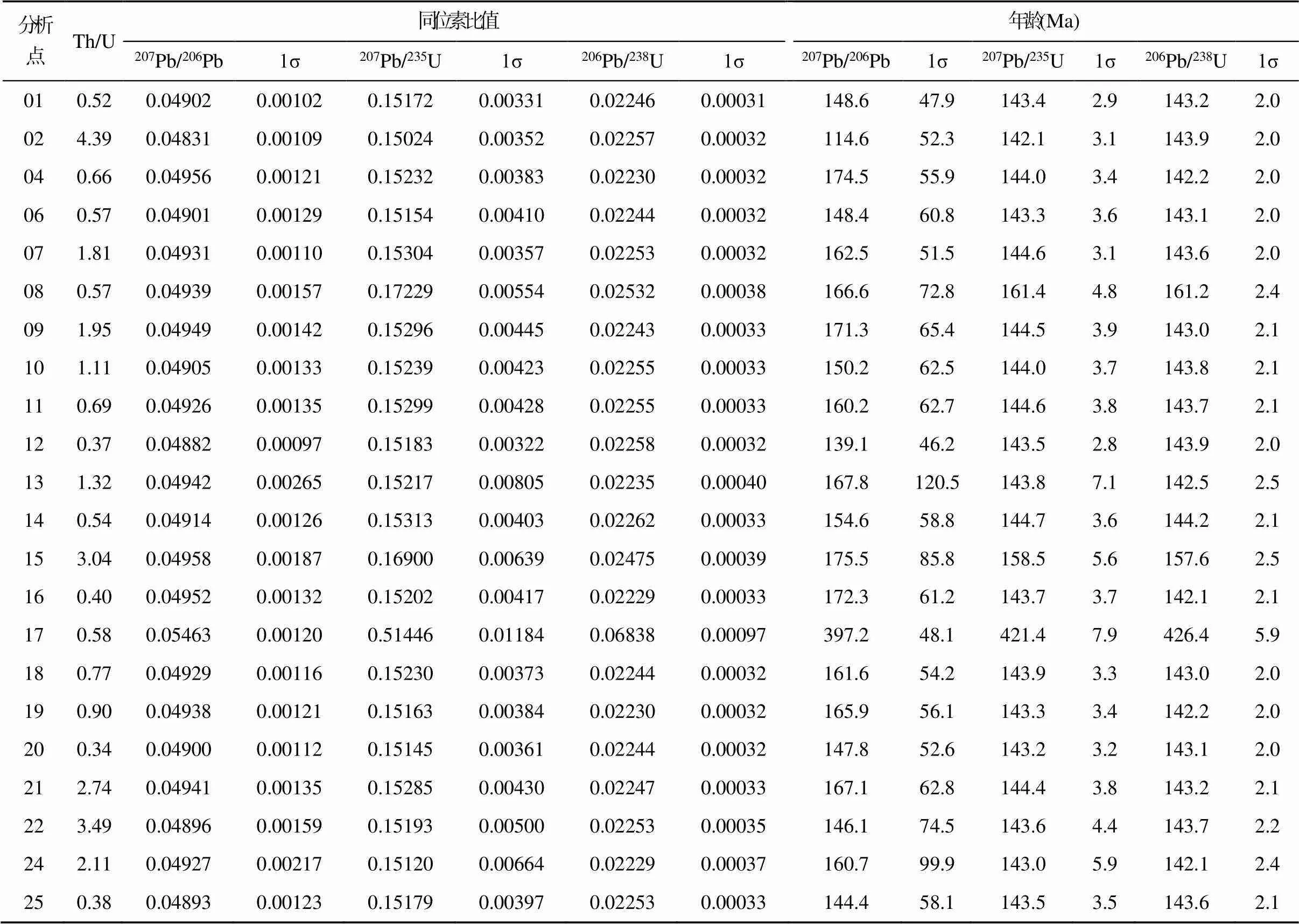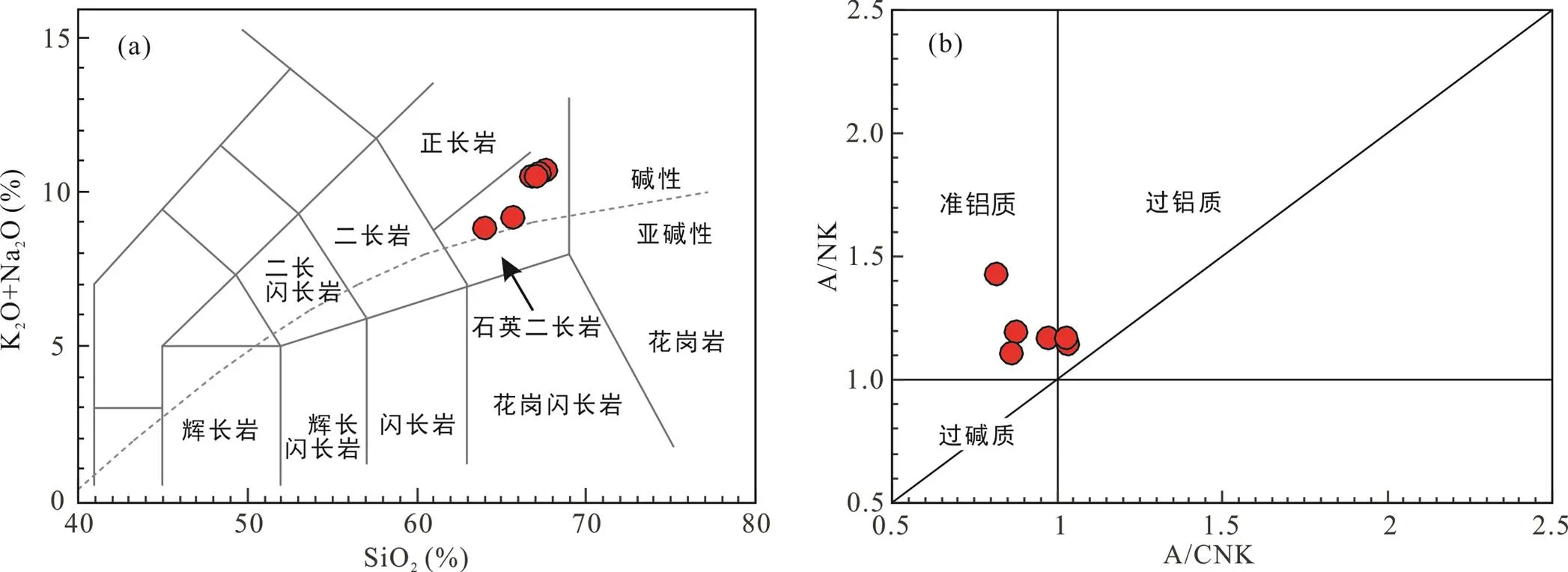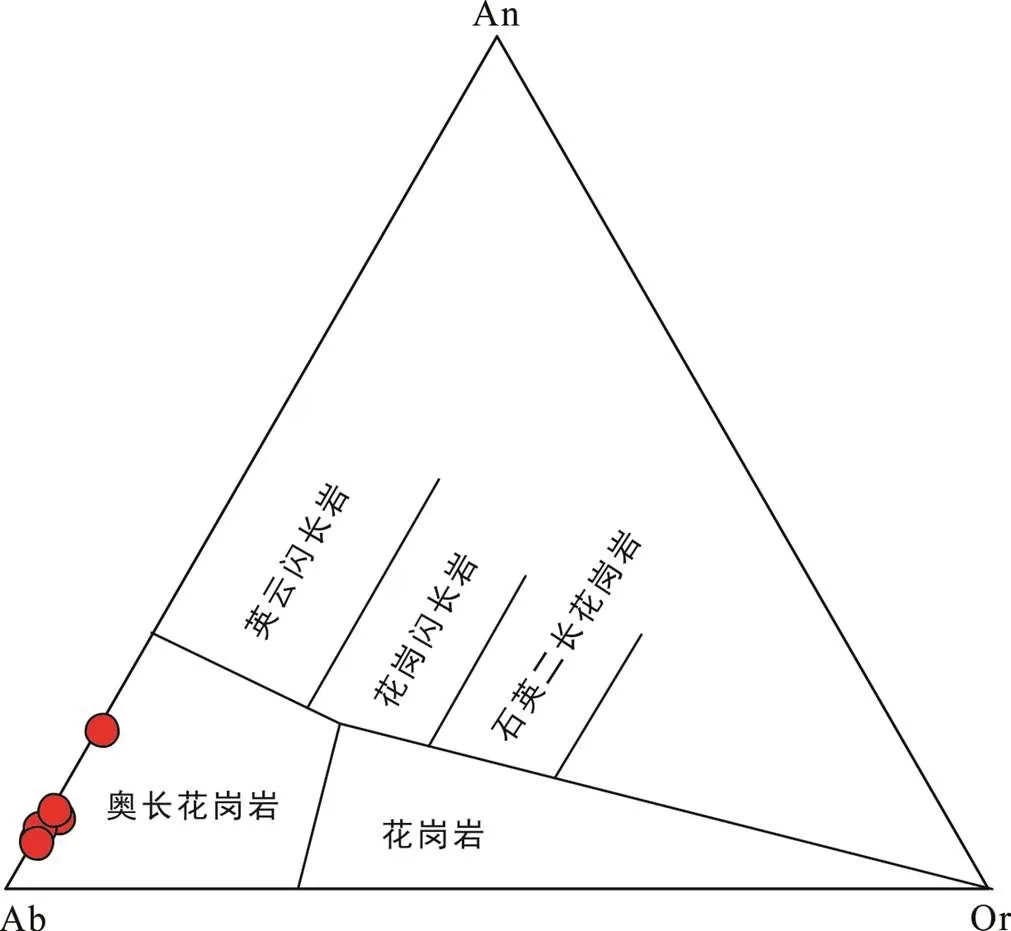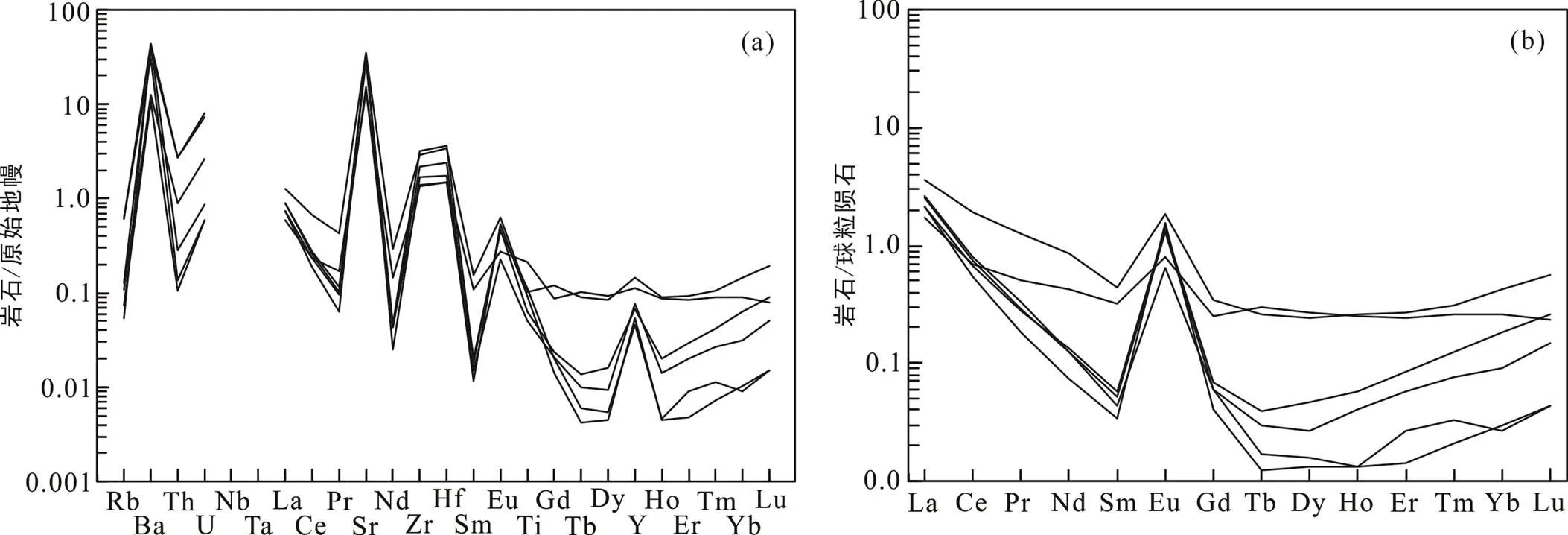加里曼丹东南部梅拉图斯斜长花岗岩的锆石U-Pb年代学及其地质意义
2022-07-08王逸文陈新跃甘成势
王逸文, 陈新跃*, 甘成势
加里曼丹东南部梅拉图斯斜长花岗岩的锆石U-Pb年代学及其地质意义
王逸文1, 陈新跃1*, 甘成势2
(1. 湖南科技大学 地球科学与空间信息工程学院, 湖南 湘潭 410201; 2. 中山大学 地球科学与工程学院, 广东省地球动力作用与地质灾害重点实验室, 广东 珠海 519082)
加里曼丹岛位于特提斯和太平洋构造域的交汇之处, 是研究两大构造域演化、延伸及耦合的关键地区。梅拉图斯蛇绿混杂岩呈近S-N向分布于加里曼丹岛东南部, 但该蛇绿混杂岩带的年代学、构造归属及其与特提斯和太平洋构造域的亲缘性存在争议。本文针对梅拉图斯蛇绿混杂岩带内的斜长花岗岩开展了岩相学、年代学、主量和微量元素、Sr-Nd同位素地球化学分析。LA-ICPMS锆石U-Pb年代学结果揭示斜长花岗岩的结晶年龄为143.2±0.5 Ma(MSWD=0.4)。斜长花岗岩样品具较高的Ab含量(74%~91%), 属于奥长花岗岩, 其SiO2=62.95%~66.92%, Al2O3=17.81%~20.48%, MgO=0.09%~3.02%, Fe2O3<0.92%, Na2O=8.62%~10.61%, K2O=0.06%~0.22%和TiO2<0.05%。样品A/CNK和A/NK值分别为0.82~1.03和1.11~1.43, 属于准铝质‒弱过铝质花岗岩系列。斜长花岗岩富集大离子亲石元素和轻稀土元素, 具显著的Ba、Sr和Eu正异常特征, 具较低的(87Sr/86Sr)i值(0.70493)和较高的Nd()值(+3.6), 为基性岩部分熔融的产物。综合对比结果显示, 梅拉图斯蛇绿混杂岩与爪哇岛卢克乌璐蛇绿混杂岩在年代学、岩石组合及地球化学特征上相近, 二者都属于特提斯洋产物。
斜长花岗岩; 梅拉图斯蛇绿混杂岩; 加里曼丹; 特提斯构造域
0 引 言
东南亚位于欧亚大陆东南缘, 处于欧亚板块、菲律宾板块和印度‒澳大利亚板块的交汇区域(图1a), 毗邻特提斯洋和太平洋两大汇聚带。由于东南亚及其周缘地区发现与特提斯洋和太平洋演化相关的丰富记录, 已成为国内外众多学者关注的热点地区(Hutchison, 1989; Metcalfe, 1990, 2005, 2013, 2021; Wang et al., 2018, 2021, 2022a)。加里曼丹岛(又称婆罗洲)及其周缘地区位于特提斯和太平洋构造域的接合部位, 在毗邻加里曼丹岛的南西部和北东部均发现与特提斯和太平洋构造域相关的晚中生代地质记录, 因此成为研究两大构造域叠加和耦合的关键地带(图1a、b; Hutchison, 1989, 2005; Hennig et al., 2017)。
加里曼丹岛东南部绝大部分地区被新生代沉积岩覆盖, 以出露近S-N向带状展布的梅拉图斯(Meratus)蛇绿混杂岩为特征。加里曼丹岛南部与特提斯的演变有关, 由爪哇岛早白垩世卢克乌璐(Luk Ulo)蛇绿混杂岩及其西延的苏门答腊岛沃伊拉(Woyla)晚侏罗世‒早白垩世俯冲增生杂岩组成; 其北部与太平洋俯冲作用有关, 由巴拉望岛中晚侏罗世混杂堆积岩和菲律宾卡拉棉群岛二叠纪‒白垩纪俯冲增生杂岩等组成(图1a; Wakita et al., 1994a, 1994b; Barber, 2000; Kadarusman et al., 2007; Yumul et al., 2009; 周蒂和孙珍, 2017)。因此加里曼丹岛东南部的梅拉图斯蛇绿混杂岩的年代学及其构造属性是剖析两大构造域叠合的关键要素, 但时至今日, 对该蛇绿混杂岩带的年代学及其构造归属等仍存在诸多争议(图1b; Parkinson et al., 1998; Wakita et al., 1998)。斜长花岗岩以富钠而贫钾为特征, 通常出现在现代洋壳和代表古老洋壳的蛇绿岩中, 对于限定洋壳和蛇绿岩的形成时代、增生过程及演化具重要意义(Koepke et al., 2004; Tilton et al., 2012; Grimes et al., 2013; Xu et al., 2017; Zhang et al., 2020)。本研究选取梅拉图斯蛇绿岩中斜长花岗岩开展了岩相学、锆石U-Pb年代学和元素地球化学研究, 为探讨梅拉图斯蛇绿混杂岩的大地构造归属提供了基础数据。
1 区域地质背景及岩相学特征
加里曼丹岛东部与苏禄海‒西里伯斯海‒望加锡海峡‒西苏拉威西岛相连, 南部及西部与苏门答腊岛‒爪哇岛‒马来半岛相隔, 北接中国南海‒菲律宾巴拉望岛, 主要由西南加里曼丹、古晋带、锡布带、米里带及东加里曼丹等五部分组成(图1a、b; Haile, 1974; Hutchison, 1989, 2005; Breitfeld et al., 2019)。西南加里曼丹通常被认为是从冈瓦纳大陆裂离而拼贴至巽他陆块的微陆块(Haile, 1974; Hall et al., 2009; Metcalfe, 2013, 2021; Davies et al., 2014)。古晋带是一条重要的E-W向构造岩浆带, 被认为与古太平洋板块的俯冲作用有关(Katili, 1971; Breitfeld et al., 2017; Hennig et al., 2017)。锡布带主要发育一套晚白垩世‒古近纪深海‒半深海复理石沉积(拉让江群); 而米里带则以一套新近纪陆源碎屑岩和碳酸盐岩沉积为主, 不整合覆盖于拉让江群之上(Haile, 1974; Hutchison, 1989, 2005; Galin et al., 2017; Hall and Breitfeld, 2017)。东加里曼丹绝大部分地区被新生代沉积岩所覆盖, 出露特鲁克和梅拉图斯蛇绿岩组合(Hutchison, 1989, 2005; Wakita et al., 1998; Parkinson et al., 1998)。

图1 环南海地区地理概图及加里曼丹简略地质图(据Galin et al., 2017修改)
梅拉图斯地区出露地层主要有白垩系、新生界及蛇绿混杂岩, 白垩系Pitap组不整合上覆于梅拉图斯蛇绿混杂岩之上(Hamilton, 1979; Sikumbang, 1990; Wakita et al., 1998; Setiawan et al., 2015)。上白垩统Haruyan组以中基性火山熔岩、凝灰岩和凝灰质角砾岩为主, Pitap组主要由砾岩、砂岩、钙质泥岩及灰岩夹层组成(Wakita et al., 1998)。
蛇绿混杂岩呈带状分布于梅拉图斯山脉和劳特岛等地, 主要由变质岩、蛇绿岩、碎屑岩、碳酸盐岩和硅质岩等岩块和强烈变形的基质组成(Hamilton, 1979; Wakita et al., 1998; Setiawan et al., 2015)。带内变质岩主要有绿帘石蓝闪石片岩、石英云母片岩、滑石片岩、石英片岩和云母石英片岩, 蛇绿岩主要包括有超基性岩、辉长‒辉绿岩、枕状玄武岩和斜长花岗岩等, 而碎屑岩、碳酸盐岩和硅质岩主要有硅质岩、硅质页岩、灰岩和泥灰岩等(Sikumbang, 1990; Wakita et al., 1998; Sikumbang and Heryanto, 2009; Setiawan et al., 2015)。本研究的斜长花岗岩呈不规则脉状和透镜状产出于超基性岩中(图2a、b)。斜长花岗岩具细粒花岗结构和块状构造, 主要矿物有斜长石(60%~80%)和石英(30%~40%), 含少量角闪石(<5%)。其中斜长石呈自形‒半自形板状镶嵌于石英颗粒之上, 石英呈粒状充填于斜长石颗粒之间(图2c、d)。
2 分析方法
选取新鲜的岩石样品, 运用人工重砂法从中分选出锆石颗粒, 在双目显微镜下挑选透明、无裂缝和晶形完好的锆石颗粒, 再用环氧树脂将它们固定并抛光至锆石颗粒中心位置。在光学显微镜和扫描电子显微镜下观察并记录锆石颗粒的形态和内部结构特征。锆石U-Pb年代学测试在广东省地球动力作用与地质灾害重点实验室完成, 所用仪器主要包括iCAP RQ型电感耦合等离子体质谱仪(ICP-MS)和Geolas HD型激光剥蚀系统(LA)。详细的分析方法和实验过程见Wang et al. (2020)。采用91500和Plešovice进行U-Pb同位素的分馏校正, NIST SRM610进行微量元素的校正。样品的锆石U-Pb年龄采用GLITTER软件处理, 加权平均年龄计算及谐和图采用Isoplot(rev. 2.50)程序绘制(Ludwig et al., 2009)。

矿物代号: Qz. 石英; Pl. 斜长石。
样品主量、微量元素和Sr-Nd同位素测试均在广东省地球动力作用与地质灾害重点实验室完成。主量元素测试在ARL-Perform’X4200型荧光光谱仪(XRF)上完成。微量元素和Sr-Nd同位素测试分别在iCAP RQ型ICP-MS和Neptune Plus型多接收电感耦合等离子体质谱仪上完成。详细的分析方法见Wang et al. (2020)。
3 结 果
3.1 锆石U-Pb年代学
对斜长花岗岩样品(18JV-26-5)中22颗锆石开展了U-Pb定年分析, 分析结果见表1。锆石呈透明状, 短柱状, 长宽比为1∶1~2∶1, 长80~120 μm, CL图像可见韵律环带结构, Th/U值变化于0.34~4.39之间, 为典型岩浆成因锆石。其中第8、15和17号分析点具较大的206Pb/238U表观年龄, 分别为161 Ma、158 Ma和426 Ma, 属于捕获锆石年龄; 其余锆石的206Pb/238U表观年龄变化范围为142~144 Ma, 加权平均年龄为143.2±0.5 Ma(MSWD=0.4,=19; 图3), 代表了斜长花岗岩的结晶年龄。
3.2 主量、微量元素和Sr-Nd同位素组成
对梅拉图斯蛇绿岩中6件斜长花岗岩样品开展主量、微量元素分析测试(表2)。结果显示, 斜长花岗岩样品SiO2含量变化范围为62.95%~66.92%, K2O+Na2O含量介于8.78%~10.70%之间, 样品中Al2O3(17.81%~20.48%)和Na2O(8.62%~10.61%)含量高, MgO(0.09%~3.02%)、FeOT(<0.92%)、K2O(0.06%~0.22%)和TiO2(<0.05%)含量低。在TAS图解中, 样品点落入石英二长岩范围内(图4a); A/CNK值为0.82~1.03(平均值为0.93), A/NK值为1.11~1.43(平均值为1.20), 属于准铝质‒弱过铝质花岗岩系列(图4b)。CIPW标准矿物计算得出其An含量变化于5%~17%之间, Ab和Or含量分别变化于74%~91%和0~1%, 在An-Ab-Or图解中样品落入奥长花岗岩范围(图5)。在原始地幔标准化微量元素蛛网图(图6a)上, 样品相对富集大离子亲石元素, 具显著的Ba、Sr和Zr-Hf正异常。样品的稀土元素总量较低, 变化范围为1.0×10−6~3.0×10−6(表2)。在球粒陨石标准化稀土元素配分模式图(图6b)中, 样品相对富集轻稀土元素和重稀土元素而亏损中稀土元素, (La/Yb)N=6.6~ 97.5, (La/Yb)N=0.4~2.2, 具明显Eu正异常的特征。Sr-Nd同位素结果(表2)显示, 梅拉图斯斜长花岗岩的87Sr/86Sr值为0.704928, (87Sr/86Sr)i为0.70493,Nd()值为+3.6。

表1 梅拉图斯蛇绿混杂岩带内斜长花岗岩的LA-ICPMS锆石U-Pb年代学分析结果

图3 梅拉图斯蛇绿混杂岩带内斜长花岗岩的锆石U-Pb年龄谐和图

表2 梅拉图斯蛇绿混杂岩带内斜长花岗岩的主量元素(%)、微量元素(×10−6)和Sr-Nd同位素分析结果

续表2:

图4 梅拉图斯蛇绿混杂岩带内斜长花岗岩(K2O+Na2O)-SiO2(a)和A/NK-A/CNK(b)图解
4 讨 论
4.1 梅拉图斯蛇绿混杂岩的形成年龄
斜长花岗岩常常作为蛇绿混杂岩的组成部分之一, 对于限定蛇绿混杂岩的形成时代具有重要意义(Grimes et al., 2013; Xu et al., 2017; Zhang et al., 2020)。本文首次获得了蛇绿混杂岩带内斜长花岗岩的锆石U-Pb年龄为143.2±0.5 Ma。已有的资料表明, 梅拉图斯蛇绿混杂岩带内的硅质岩和硅质页岩中含大量早白垩世放射虫化石(Wakita et al., 1998)。该蛇绿岩带内石榴石‒角闪石片岩和绿泥石‒绿帘石片岩的Rb-Sr等时线年龄为116~110 Ma, 蓝闪石片岩Rb-Sr等时线年龄为113 Ma, 云母石英片岩的K-Ar年龄集中于约119~110 Ma(Wakita et al., 1998; Alfing et al., 2021), 这些变质岩与爪哇岛卢克乌璐和苏拉威西岛班迪马拉蛇绿混杂岩带内变质岩具相似的形成年龄(Wakita et al., 1994b; Böhnke et al., 2019; Hoffmann et al., 2019; Alfing et al., 2021)。Soesilo (2012)、Soesilo et al. (2014)和Wakita et al. (1998)在Purui Dalam获得斜长花岗岩全岩K-Ar年龄为155 Ma。Soesilo (2012)也在梅拉图斯蛇绿混杂岩中获得了~137 Ma的变质岩锆石U-Pb年龄。Wang et al. (2022b)获得了该蛇绿岩带内玄武岩的锆石U-Pb年龄为128±2 Ma。带内硅质岩中火山夹层的锆石U-Pb年龄变化范围为140~121 Ma, 峰值集中于127 Ma (Wang et al., 2022b)。另外上覆于梅拉图斯蛇绿混杂岩之上的Pitap组页岩和硅质岩含有晚白垩世Aptian晚期‒Cenomanian早期(约115~100 Ma)放射虫和软体动物化石(Supriatna, 1989; Wakita et al., 1998)。综合研究表明, 梅拉图斯蛇绿混杂岩带很可能形成于约115~145 Ma的早白垩世。

图5 梅拉图斯蛇绿混杂岩带内斜长花岗岩An-Ab-Or图解
4.2 岩石成因及地质意义
斜长花岗岩的岩石成因模式主要有两种: ①基性岩浆分离结晶(Lippard et al., 1986; Floyd et al., 1998; Jiang et al., 2008); ②辉长岩或斜长角闪岩部分熔融(Flagler and Spray, 1991; Koepke et al., 2004; Zi et al., 2012; Grimes et al., 2013)。梅拉图斯蛇绿混杂岩带内斜长花岗岩具较低的Rb/Sr值(<0.001)、TiO2含量和中等SiO2含量, 显著Ba、Sr和Eu正异常(图6), 这些特征不同于由基性岩浆分离结晶而形成的斜长花岗岩(Floyd et al., 1998; Jiang et al., 2008)。相反, 其较低的Zr(15×10−6~36×10−6)、Y(0.21×10−6~ 0.67×10−6)含量及Zr/Y值(29~120), 与Karmoy型斜长花岗岩相似(Pedersen and Malpas, 1984)。此外, 梅拉图斯斜长花岗岩具较高的Nd()值(+3.6), 接近于带内基性岩的Nd()值(Wang et al., 2022b)。地球化学特征暗示, 梅拉图斯斜长花岗岩可能是辉长岩或斜长角闪岩部分熔融的产物。

图6 梅拉图斯蛇绿混杂岩带内斜长花岗岩原始地幔标准化的微量元素蛛网图(a)和球粒陨石标准化稀土元素配分曲线(b)(原始地幔和球粒陨石值引自Sun and McDonough, 1989)
目前关于梅拉图斯蛇绿混杂岩带的构造属性及其与特提斯和太平洋构造域的关联依然存在争议, 一种观点认为该蛇绿混杂岩带与爪哇岛卢克乌璐和苏拉威西岛班迪马拉蛇绿混杂岩带相连, 属于特提斯构造域范畴(颜佳新, 2005; 鲁宝亮等, 2014; 周蒂和孙珍, 2017); 而另一种观点认为该蛇绿混杂岩带与特鲁克蛇绿岩带相接, 受太平洋构造域的影响(Hamilton, 1979; Metcalfe, 1990, 2005; Parkinson et al., 1998; Setiawan et al., 2013)。
本次研究表明梅拉图斯蛇绿混杂岩带形成于约145~115 Ma的早白垩世, 前人研究显示, 爪哇岛卢克乌璐和苏拉威西岛班迪马拉蛇绿混杂岩也形成于早白垩世, 三者的峰期变质作用均同步发生在119~110 Ma(表3; Wakita et al., 1994a, 1994b, 1998; Parkinson et al., 1998; Setiawan et al., 2013, 2015; White et al., 2016)。另外, 班迪马拉混杂岩中石榴石云母片岩的峰期变质温压分别为615~678 ℃和2.6~2.7 GPa(Setiawan et al., 2013, 2015), 卢克乌璐混杂岩中榴辉岩峰期变质温压分别为473~557℃和2.1~2.3 GPa(Kadarusman et al., 2007; Setiawan, 2013); 梅拉图斯蛇绿混杂岩中的变质岩峰期变质温压为547~690℃和1.1~1.5 GPa(Setiawan et al., 2013, 2015)。由此可知三条混杂岩带内变质岩具相似的峰期变质温压条件和顺时针的-轨迹(表3; Setiawan et al., 2013, 2015)。此外, 沉积岩碎屑锆石U-Pb年龄数据也揭示加里曼丹东南部、南苏拉威西及爪哇岛均具有与澳大利亚地区相似的锆石年龄谱系, 显示出澳大利亚亲缘性(Hennig et al., 2017; Decker et al., 2017; Hoffmann et al., 2019; Zhang et al., 2021)。相反, 沙巴地区特鲁克蛇绿岩带形成时代明显年轻, 其变质程度相对微弱(Hamilton, 1979; Metcalfe, 1990, 2021); 且婆罗洲东北部沙巴地区碎屑锆石年龄谱系明显不同于冈底斯‒澳大利亚的碎屑锆石年龄谱系, 而与华南大陆相似(Wang et al., 2013)。因此本文更倾向认为梅拉图斯蛇绿混杂岩带与爪哇岛卢克乌璐和苏拉威西岛班迪马拉蛇绿混杂岩带相连, 均受特提斯洋俯冲的影响。

表3 加里曼丹东南部及其周缘地区蛇绿混杂岩带内变质岩特征汇总
5 结 论
(1) 梅拉图斯蛇绿混杂岩带中斜长花岗岩的结晶年龄为143.2±0.5 Ma, 属早白垩世产物。
(2) 梅拉图斯蛇绿混杂岩与爪哇岛卢克乌璐蛇绿混杂岩具相似的特征, 属特提斯洋产物。
致谢:感谢中山大学王玉琨和杨雪博士在锆石U-Pb年代学、主量和微量元素、Sr-Nd同位素测试过程中的帮助。三位匿名审稿专家为论文提出了建设性意见和建议, 在此表示衷心感谢!
鲁宝亮, 王璞珺, 梁建设, 孙晓猛, 王万银. 2014. 古南海构造属性及其与特提斯和古太平洋构造域的关系. 吉林大学学报(地球科学版), 44(5): 1441–1450.
颜佳新. 2005. 加里曼丹岛和马来半岛中生代岩相古地理特征及其构造意义. 热带海洋学报, 24(2): 26–32.
周蒂, 孙珍. 2017. 晚中生代以来太平洋域板块过程及其对东亚陆缘构造研究的启示. 热带海洋学报, 36(3): 1–19.
Alfing J, Brocker M, Setiawan N I. 2021. Rb-Sr geochronology of metamorphic rocks from the Central Indonesian Accretionary Collision Complex: Additional age constraintsfor the Meratus and Luk Ulo Complexes (South Kalimantan and Central Java)., 388–389, 105971.
Barber A J. 2000. The origin of the Woyla Terranes in Sumatraand the Late Mesozoic evolution of the Sundaland margin., 18(6): 713–738.
Böhnke M, Bröcker M, Maulana A, Klemd R, Berndt J, Baier H. 2019. Geochronology and Zr-in-rutile thermometry of high-pressure/low temperature metamorphic rocks from the Bantimala complex, SW Sulawesi, Indonesia., 324–325: 340–355.
Breitfeld H T, Hall R, Galin T, Forster M A, BouDagher- Fadel M K. 2017. A Triassic to Cretaceous Sundaland- Pacific subduction margin in West Sarawak, Borneo., 694: 35–56.
Breitfeld H T, Macpherson C, Hall R, Thirlwall M, Ottley C J, Hennig-Breitfeld J. 2019. Adakites without a slab: Remelting of hydrous basalt in the crust and shallow mantle of Borneo to produce the Miocene Sintang Suite and Bau Suite magmatism of West Sarawak., 344(1): 100–121.
Davies L, Hall R, Armstrong R. 2014. Cretaceous crust in SW Borneo: Petrological, geochemical and geochronological constraints from the Schwaner Mountains. Jakarta: Proceedings Indonesian Petroleum Association 38thAnnual Convention and Exhibition, IPA14-G-025.
Decker J, Ferdian F, Morton A, Fanning M, White L T. 2017. New geochronology data from eastern Indonesia — An aid to understanding sedimentary provenance in a frontierregion. Jakarta: Proceedings of the Indonesian Petroleum Association, 41thAnnual Convention and Exhibition, IPA17-551-G: 1–18.
Flagler P A, Spray J G. 1991. Generation of plagiogranite by amphibolite anatexis in oceanic shear zones., 19(1): 70–73.
Floyd P A, Yaliniz M K, Goncuoglu M C. 1998. Geochemistry and petrogenesis of intrusive and extrusive ophiolitic plagiogranites, Central Anatolian Crystalline Complex, Turkey., 42(3–4): 225–241.
Galin T, Breitfeld H T, Hall R, Sevastjanova I. 2017. Provenance of the Cretaceous-Eocene Rajang Group submarine fan, Sarawak, Malaysia from light and heavy mineral analysis and U-Pb zircon geochronology., 51: 209–233.
Grimes C B, Ushikubo T, Kozdon R, Valley J W. 2013. Perspectives on the origin of plagiogranite in ophiolites from oxygen isotopes in zircon., 179: 48–66.
Haile N S. 1974. Borneo // Spencer A M. Mesozoic-Cenozoic Orogenic Belts.,,, 4: 333–347.
Hall R, Breitfeld H T. 2017. Nature and demise of the proto-South China Sea., 63: 61–76.
Hall R, Clements B, Smyth H R. 2009. Sundaland: Basement character, structure and plate tectonic development. Jakarta: Proceedings Indonesian Petroleum Association 33rdAnnual Convention, IPA09-G-134: 1–27.
Hamilton W B. 1979. Tectonics of the Indonesian region. Washington: US Government Printing Office: 1078.
Hennig J, Breitfeld H T, Hall R, Nugraha A M S. 2017. The Mesozoic tectono-magmatic evolution at the Paleo-Pacific subduction zone in West Borneo., 48: 292–310.
Hoffmann J, Bröcker M, Setiawan N I, Klemd R, Berndt J, Maulana A, Baier H. 2019. Age constraints on high-pressure/ low-temperature metamorphism and sedimentation in the Luk Ulo complex (Java, Indonesia)., 324–325: 747–762.
Hutchison C S. 1989. Geological Evolution of South-east Asia. London: Clarendon Press Oxford: 368.
Hutchison C S. 2005. Geology of North-West Borneo. Elsevier: Science limited: 383–397.
Jiang Y H, Liao S Y, Yang W Z, Shen W Z. 2008. An island arc origin of plagiogranites at Oytag, western Kunlun orogen, northwest China: SHRIMP zircon U-Pb chronology, elemental and Sr-Nd-Hf isotopic geochemistry and Palaeozoic tectonic implications., 106(3–4): 323–335.
Kadarusman A, Massonne H J, van Roermund H, Permana H, Munasri. 2007.-evolution of eclogites and blueschists from the Luk Ulo complex of Central Java, Indonesia., 49(4): 329–356.
Katili J A. 1971. A review of the geotectonic theories and tectonic maps of Indonesia., 7(3): 143–163.
Koepke J, Feig S T, Snow J, Freise M. 2004. Petrogenesis of oceanic plagiogranites by partial melting of gabbros: An experimental study., 146: 414–432.
Lippard S J, Shelton A W, Gass I G. 1986. The Ophiolite of Northern Oman. Oxford: Geological Society Memoir, 11, Blackwell Scientific: 178.
Ludwig K. 2009. Sqiud 2: A User’s Manual. Berkeley Geochron Center Special publication, 5: 1–110.
Metcalfe I. 1990. Allochthonous terrane processes in Southeast Asia.,, 331(1620): 625–640.
Metcalfe I. 2005. Asia: South-east., 1: 169–198.
Metcalfe I. 2013. Gondwana dispersion and Asian accretion: Tectonic and palaeogeographic evolution of eastern Tethys., 66: 1–33.
Metcalfe I. 2021. Multiple Tethyan ocean basins and orogenic belts in Asia., 100: 87–130.
Parkinson C D, Miyazaki K, Wakita K, Barber A J, Carswell D A. 1998. An overview and tectonic synthesis of the pre-Tertiary very-high-pressure metamorphic and associated rocks of Java, Sulawesi and Kalimantan, Indonesia., 7(1–2): 184–200.
Pedersen R B, Malpas J. 1984. The origin of oceanic plagiogranites from the Karmoy ophiolite, western Norway., 88(1): 36–52.
Setiawan N I, Osanai Y, Nakano N, Adachi T, Asy’ari A. 2015. Metamorphic evolution of garnet-bearing epidote- barroisite schist from the Meratus complex in South Kalimantan, Indonesia., 2(3): 139–156.
Setiawan N I, Osanai Y, Nakano N, Adachi T, Yonemura K, Yoshimoto A, Wahyudiono J, Mamma K. 2013. An overview of metamorphic geology from Central Indonesia: Importance of South Sulawesi, Central Java and South-West Kalimantan metamorphic terranes., 19: 39–55.
Sikumbang N. 1990. Geology and tectonics of Pre-Tertiary rocks in the Meratus Mountains Southeast Kalimantan, Indonesia., 13(2): 1–31.
Sikumbang N, Heryanto R. 2009. Geological map of the Banjarmasin Quadrangle, Kalimantan. Scale 1∶250,000.Geological Research and Development Centre of Indonesia, Bandung.
Soesilo J. 2012. Cretaceous Paired Metamorphic Belts in Southeast Sundaland. Bandung Institute of Technology Indonesia: 180.
Soesilo J, Schenk V, Suparka E, Abdullah C I, Amiruddin A. 2014. The K-Ar and U-Pb SHRIMP Zircon Age Dating of The Batangalai Pluton Central Meratus Complex, Southeast Kalimantan. Jakarta: Prosiding Seminar NasionalGeologi Nuklir Dan Sumber Daya Tambang Tahun: 1–16.
Sun S S, McDonough W F. 1989. Chemical and isotopic systematics of oceanic basalts: Implications for mantle composition and processes.,,, 42: 313–345.
Supriatna S. 1989. Data Baru Mengenai geologi Pegunungan meratus Kalimantan Selantan., 13: 30–38.
Tilton G R, Hopson C A, Wright J E. 2012. Uranium-lead isotopic ages of the Samail Ophiolite, Oman, with applications to Tethyan ocean ridge tectonics.:, 86(B4): 2763– 2775.
Wakita K, Miyazaki K, Zulkarnain I, Sopaheluwakan J, Sanyoto P. 1998. Tectonic implications of new age data for the Meratus complex of South Kalimantan, Indonesia., 7(1–2): 202–222.
Wakita K, Bambang W. 1994a. Cretaceous radiolariansfrom the Luk-Ulo melange complex in the Karangsambung area, Central Java, Indonesia., 9(1–2): 29–43.
Wakita K, Sopaheluwakan J, Zulkarnain I, Miyazaki K. 1994b. Early Cretaceous tectonic events implied in the time-lag between the age of radiolarian chert and its metamorphic basement in the Bantimala area, South Sulawesi, Indonesia., 3(2): 90–102.
Wang Y J, Fan W M, Zhang G W, Zhang Y H. 2013. Phanerozoic tectonics of the South China Block: Key observations and controversies., 23(4): 1273–1305.
Wang Y J, Liu Z, Murtadha S, Cawood P A, Qian X, Ghani A, Gan C S, Zhang Y Z, Wang Y, Li S, Zhang P Z. 2022a. Jurassic subduction of the Paleo-Pacific Plate in Southeast Asia: New insights from the igneous and sedimentary rocks in West Borneo., https: //doi.org/10.1016/j.jseaes.2022.105111.
Wang Y J, Qian X, Cawood P A, Ghani A, Gan C S, Wu S N, Zhang Y Z, Wang Y, Zhang P Z. 2022b. Cretaceous Tethyan subduction in SE Borneo: Geochronological andgeochemical constraints from the igneous rocks in the Meratus Complex., 226(3–4), 105084.
Wang Y J, Qian X, Cawood P A, Liu H C, Feng Q L, Zhao G C, Zhang Y Z, He H Y, Zhang P Z. 2018. Closure of the East Paleotethyan Ocean and amalgamation of the Eastern Cimmerian and Southeast Asia continental fragments., 186: 195–230.
Wang Y J, Qian X, Zhang Y Z, Gan C S, Zhang A M, Zhang F F, Feng Q L, Cawood P A, Zhang P Z, 2021. Southern extension of the Paleotethyan zone in SE Asia: Evidence from the Permo-Triassic granitoids in Malaysia and West Indonesia., 398–399, 106336.
Wang Y J, Yang T X, Zhang Y Z, Qian X, Gan C S, Wang Y K, Wang Y, Senebouttalath V. 2020. Late Paleozoic back-arc basin in the Indochina block: Constraints from the mafic rocks in the Nan and Luang Prabang tectonic zones, Southeast Asia.,195(1), 104333.
White L T, Graham I, Tanner D, Hall R, Armstrong R A, Yaxley G, Barron L, Spencer L, van Leeuwen T. 2016. The provenance of Borneo’s enigmatic alluvial diamonds: A case study from Cempaka, SE Kalimantan., 38: 251–272.
Xu Y, Liu C Z, Chen Y, Guo S, Wang J G, Sein K. 2017. Petrogenesis and tectonic implications of gabbro and plagiogranite intrusions in mantle peridotites of the Myitkyina ophiolite, Myanmar., 284–285: 180–193
Yumul G P, Dimalanta C B, Marquez E J, Queaño K L. 2009. On land signatures of the Palawan microcontinental block and Philippine mobile belt collision and crustal growth process: A review., 34(5): 610–623.
Zhang X, Chung S L, Tang J T, Maulana A, Mawaleda M, Oo T, Tien C Y, Lee H Y. 2021. Tracing Argoland in eastern Tethys and implications for India-Asia convergence., 133(7–8): 1712–1722.
Zhang Y Z, Yang X, Wang Y J, Qian X, Wang Y K, Gou Q Y, Senebouttalath V, Zhang A M. 2020. Rifting and subduction records of the Paleo-Tethys in North Laos: Constraints from Late Paleozoic mafic and plagiogranitic magmatism along the Song Ma tectonic zone., 133(1–2): 212–232.
Zi J W, Cawood P A, Fan W M, Wang Y J, Tohver E. 2012. Contrasting rift and subduction related plagiogranites in the Jinshajiang ophiolitic mélange, southwest China, and implications for the Paleo-Tethys., 31(2), TC2012.
Zircon U-Pb Dating and Tectonic Significance of the Plagiogranite in the Meratus Ophiolitic Mélange of SE Kalimantan
WANG Yiwen1, CHEN Xinyue1*, GAN Chengshi2
(1.School of Earth Sciences and Spatial Information Engineering, Hunan University of Science and Technology, Xiangtan 410201, Hunan, China; 2.Guangdong Provincial Key Lab of Geodynamics and Geohazards, School of Earth Sciences and Engineering, Sun Yat-sen University, Zhuhai 519082, Guangdong, China)
Kalimantan is mainly surrounded by the Tethyan and Pacific tectonic domains, and it is an important place for exploring the tectonic evolution and interaction of the two domains. The N-S trending Meratus ophiolitic mélange is located in SE Kalimantan, but the formation time and tectonic nature of this mélange are poorly constrained. This study firstly presents the zircon U-Pb age and major element contents of the plagiogranite in the Meratus ophiolitic mélange. Our data show that the plagiogranite formed at 143.2±0.5 Ma. The plagiogranite samples are characterized by high Al2O3(17.81%–20.48%) and Na2O (8.62%–10.61%) with SiO2=62.95%–66.92%, MgO=0.09%–3.02%, Fe2O3<0.92%, K2O=0.06%–0.22% and TiO2<0.05%. They are metaluminous to weakly peraluminous with A/CNK=0.82–1.03 and A/NK=1.11–1.43. The plagioclase in the plagiogranite has high Ab (74%–91%), and thus the plagiogranite can be termed as trondhjemite. They are enriched in LILE and LREE with significant Ba, Sr and Eu positive anomalies. They have low initial87Sr/86Sr ratio of 0.704927 and highNd(t) value of +3.6, likely deriving from partial melting of metasomatized gabbro or amphibolites. In combination with other data, the Meratus ophiolitic mélange has geological and geochemical features similar to those of theLuk Ulo and Bantimala ophiolitic mélanges in Central Java and SW Sulawesi, suggestive of the Tethyan subduction initiating at the earliest Cretaceous.
plagiogranite; Meratus ophiolitic mélange; Kalimantan; Tethyan domain
10.16539/j.ddgzyckx.2022.03.015
2021-12-10;
2022-02-25
国家自然科学基金项目(42002236)资助。
王逸文(2000–), 女, 学士, 岩石学专业。E-mail: 2835437696@qq.com
陈新跃(1977–), 男, 教授, 主要从事大地构造和地球化学方面研究。E-mail: xinychen@163.com
P581; P597
A
1001-1552(2022)03-0622-011
